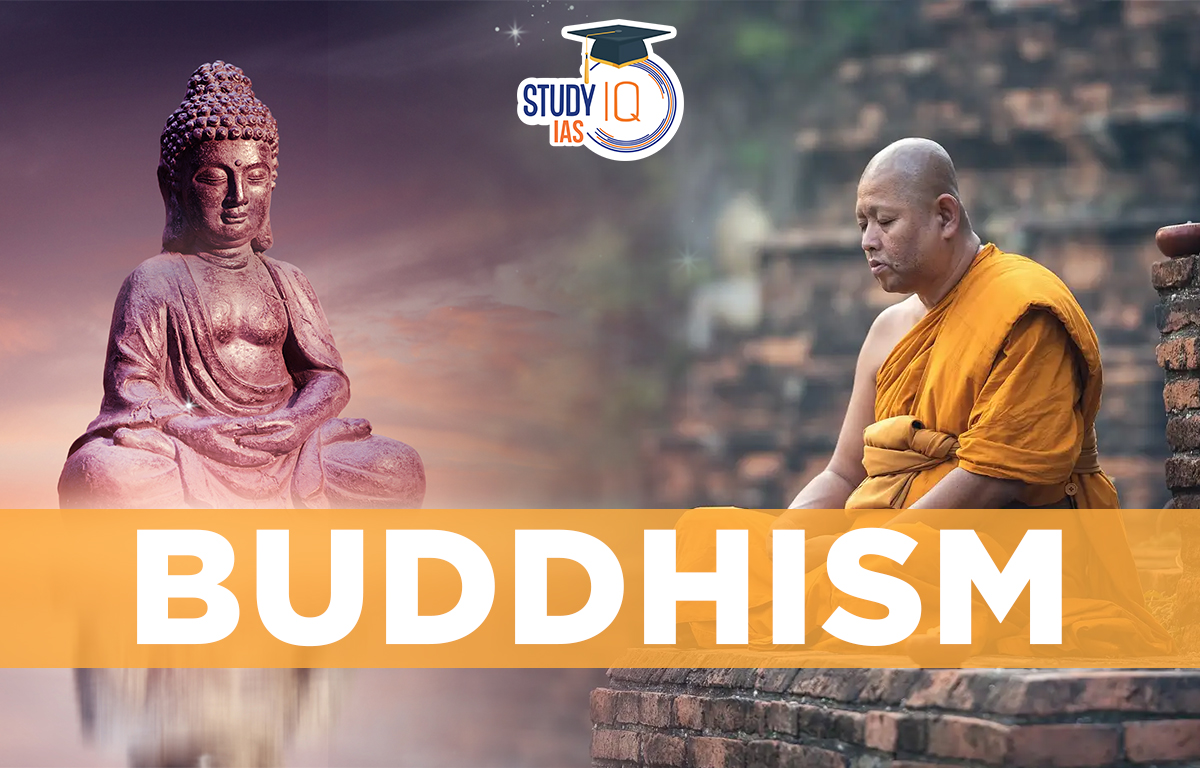Table of Contents
Context: The Prime Minister of Thailand has gifted a copy of Tipitak in Pali language to the Indian Prime Minister during his recent visit.
Buddhism
Buddha or Buddhism, the four noble truths, the eight-fold path to enlightenment, and the middle path of life are all part of the Buddha’s teachings. ‘Buddha’ is a word that refers to ‘the enlightened one. The well-established and followed socio-religious norms were criticized in the sixth century BCE by eminent scholars of the time like Confucius in China, Zoroaster in Persia, and Parmenides in Greece.
Buddhism Origin
In the year 566 B.C., Gautama established Buddhism. He was Mayadevi’s and Suddhodhan’s firstborn. Suddhodhan, his father, was the celebrated monarch of the Sakya republic. Early in life, Yasodhara and Gautama were wedded. The sight of an old man, a sick individual, and a dead body horrified Gautama.
After that, he was drawn to an ascetic’s saintly look. He abandoned his son, wife, and home one evening after giving up the material world. Gautama spent some time learning philosophy in two renowned teachers’ schools after fleeing his home. After six years of intense meditation, insights were discovered. Gautama became known as “the Enlightened One,” the Buddha.
Read about: Sangam Literature
Founder of Buddhism
The creator of Buddhism, Gautama Buddha, was born in Lumbini, close to Kapilvastu, today in Nepal, in the fifth century on Vaishakha Poornima Day. He was born a prince into a prosperous Shakya clan household. Suddhodhana was his father. Seven days after his delivery, Mahamaya, his mother, passed away. Gautami, his stepmother, raised him. married Yashodhara when she was 16; they had a son called Rahula.
After seeing an old man, a sick man, a corpse, and an ascetic, he left his luxurious existence. He then made the decision to start travelling. At the age of 29, he set out from his house with his trusted steed, Kanthaka, and charioteer, Channa. He left them and wandered for nearly six years in pursuit of the truth.
He was referred to as practising “Mahabhinishkramana,” or the Great Renunciation, during his quest for the truth. Alara Kalama was his first mentor and the person he acquired meditation techniques. At the age of 35, he achieved “Nirvana” or Enlightenment in Gaya, a town in Magadh, Bihar, under a peepal tree.
The Tathagata or Sakyamuni are other names for the Buddha. At Sarnath, he preached his first sermon to his five followers. Dharmachakrapravartan, or “Turning of the Wheel of Law,” is the name of the opening lecture. His 80-year-old life indicates that he achieved “Mahaparinirvana” in the Malla Republic’s Kushinagar, which is the same as the village of Kasia in the Deoria district of Uttar Pradesh.
Read about: Tripartite Struggle
Buddhism and Teachings of Buddha
1. The Four Noble Truths
(Dukha) Sabbam Dukkam This universe is full of sorrows and misery. And the yearning (Dukkha Samudaya) of Dwadash Nidan/Pratitya Samutpada is the root of all suffering. By reining in your desires (Dukha Nirodha), you can achieve Nirvana and put a stop to this suffering. Desires can be managed by adhering to the Eight-Fold Path (Dukha Nirodha Gamini Pratipada): Ashtanga Marga.
2. The Eight-Fold Path
The Eight-Fold Path consists of the following
- Right Understanding (Samma Ditthi)
- Right Thought (Samma sankappa )
- Right Action (Samma Kammanta)
- Right Livelihood (Samma Ajiva)
- Right Efforts (Samma Vayama)
- Right Speech (Samma vaca)
- Right mindfulness (Samma Sati)
- Right Concentration (Samma samadhi)
3. Belief in Nirvana
Rebirth ceases when desire stops. By following the Eight-Fold Path, Nirvana is reached, or freedom from the cycle of birth, death, and rebirth. Buddha said that the concept of a spirit is a myth.
According to Buddhist doctrine, there are ten different types of regions into which a person can be born. Buddha is at the top, followed by Bodhisattva (an enlightened being destined to become a Buddha but purposefully stays on earth to spread teachings), Pratyeka Buddha, Sravaka (a disciple of Buddha), heavenly beings (superhumans, angels), humans, Asura (fighting spirits), animals, Preta (hungry ghosts), and depraved men (hellish beings).
The remaining nine realms are “mutually immanent and mutually inclusive” and are found in each of the ten realms of existence. For example, the domain of human beings contains all nine other states, ranging from hell to Buddhahood. Man can be self-centred or reach Buddha’s level of enlightenment. According to Buddhism, karma is the outcome of deeds that are more dependent on the intentions than the actual action. Rebirth is the outcome of one’s past life karma. Despite emphasising non-violence, Buddhism does not prohibit people from eating meat.
Read about: Later Vedic Period
Buddhism and Buddhist Literature
The term “Tripitakas,” which translates to “A threefold basket,” is used to refer to the Buddhist scriptures written in the Pali language.
- Vinaya Pitaka: This book contains the regulations for behaviour in Buddhist monasteries.
- Sutta Pitaka: The most comprehensive compilation of Buddha’s teachings.
- Abhidhamma Pitaka: This book explains the intellectual underpinnings of Buddhism.

About Tipitaka/ Tripitaka
Tripitaka is the canonical scripture of Theravāda Buddhism, containing the teachings of Lord Buddha.
Structure of the Tripitaka (Three Baskets)
- Vinaya Pitaka:
- It contains rules and conduct for monks and nuns.
- Patimokkha – a code of monastic discipline, is part of Vinaya Pitaka.
- Sutta Pitaka:
- It contains the teachings and sermons of the Buddha.
- Divided into 5 Nikayas (collections): Digha Nikaya, Majjhima Nikaya, Samyutta Nikaya, Anguttara Nikaya, Khuddaka Nikaya.
- Abhidhamma Pitaka:
- It contains philosophical and psychological analysis of Buddha’s teachings.
- Recently Pali has been declared as a Classical Language.
Read about: Rig Vedic Period
Buddhism and Important Buddhist Council
1. First Buddhist Council
In the year 483 BC, this took place in Rajgriha’s Saptaparni grotto. Mahakasyapa presided over the formation of this committee. Ajatshatru of the Haryanka dynasty was the monarch at the time. As a consequence of this gathering, the Buddha’s teachings are split into the Vinaya Pitaka and the Sutta Pitaka. Upali read from the Vinaya Pitaka, and Ananda read from the Sutta Pitaka.
2. Second Buddhist Council
In the year 383 BC, this event took place in Chullavanga, Vaishali. Sabakami served as the council’s chairman. The Shishunaga Dynasty’s Kalashoka served as the period’s ruler during this time. There were two main schools of Buddhism: Mahasanghika and Sthaviravada.
3. Third Buddhist Council
In the year 250 BC, this took place at Ashokarama Vihar in Patliputra. Mogaliputta Tissa presided over this assembly as its leader. During this time, Ashoka, a member of the Maurya family, ruled as monarch. Abhidhamma, the third instalment of the Tripitaka, was written. It was decided to dispatch missionaries to other nations to introduce Buddhism there.
4. Fourth Buddhist Council
The fourth meeting took place in 72 AD in Kundala Van, Kashmir. Vasumitra served as the council’s head, and Ashwaghosha served as vice-chairman. The Kushana dynasty’s Kanishka presided over this assembly. Buddhists are divided into Hinayana and Mahayana schools.
Read about: Sangam Period
Buddhism Sect
1. Hinayana
Hinayana is the Hindi word for leaser. Hinayana adherents held fast to the basic teachings of Buddha. Through self-control and meditation, they pursued salvation. They disapproved of idol worship and preferred the Pali tongue. It is also referred to as the “Southern Buddhist Faith” because it was most prevalent in the southern regions of India, such as Sri Lanka, Burma (Myanmar), Thailand, Java, Laos, etc. Hinayana is divided into two subsects: Vaibhasika and Sautantrika.
2. Mahayana
This sect’s adherents held a belief in Buddha’s heavenly nature. Through the mercy of Buddha and Bodhisattva, they sought salvation. They had a preference for the Sanskrit tongue and idol worship. Due to its dominance in countries primarily in the north of India, such as China, Korea, Japan, Taiwan, etc., it is also known as “Northern Buddhist Faith.”
3. Vajrayana
The followers of this group hold that obtaining the magical ability they refer to as Vajra is the only way to achieve salvation. In Bengal and Bihar, it gained popularity. They openly ate foods that other sects deem taboo, such as meat, fish, and wine.
4. Bodhisattvas
- Vajrapani: He is the enemy of vice and evil and carries a thunderbolt.
- Padmapani, which literally translates to “the lotus bearer,” is another name for Avalokitesvara (the lord who peers down). He is benevolent.
- Manjushri (Stimulator of Understanding): This statuette is holding ten books that explain paramitas as spiritual perfections.
- Kshitigarbha: Protector of the Purgatory.
- The Future Master is known as Maitreya.
- Amitabha/Amitayusha: the heavenly Buddhist.
Read about: Gupta Empire
Buddhism UPSC
The well-established and followed socio-religious norms were criticised in the sixth century BCE by eminent scholars of the time like Confucius in China, Zoroaster in Persia, and Parmenides in Greece. They placed a strong focus on moral and ethical values. Additionally, two alternative religions—Buddhism and Jainism—emerged in India. Both of these faiths advocated and supported non-violence, upright behaviour, charity, and generosity. To know more about Buddhism candidates must visit official website of StudyIQ UPSC Online Coaching for UPSC Exam preparations.
Read about: Maurya Empire


 Jallianwala Bagh Massacre, Date, History...
Jallianwala Bagh Massacre, Date, History...
 Important Lakes of India, State wise and...
Important Lakes of India, State wise and...
 Andaman and Nicobar Islands, History, Cl...
Andaman and Nicobar Islands, History, Cl...





















